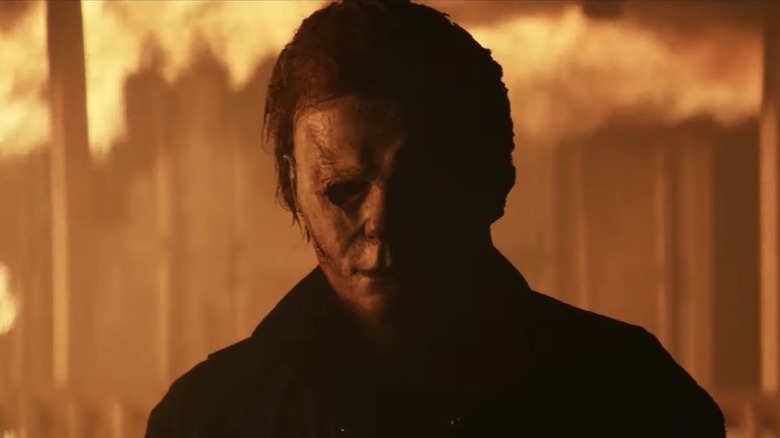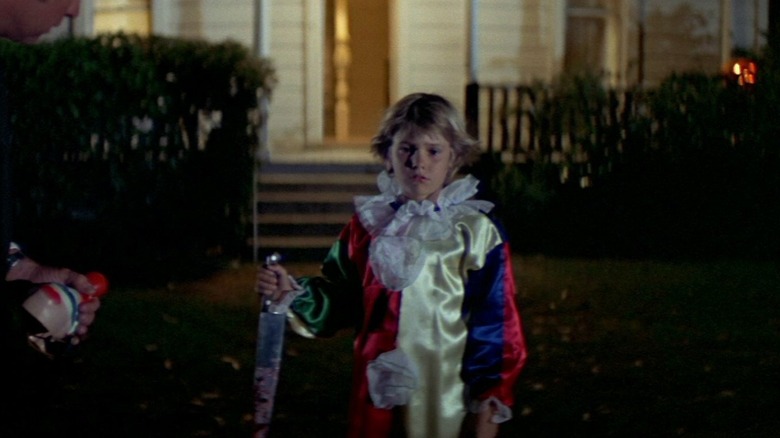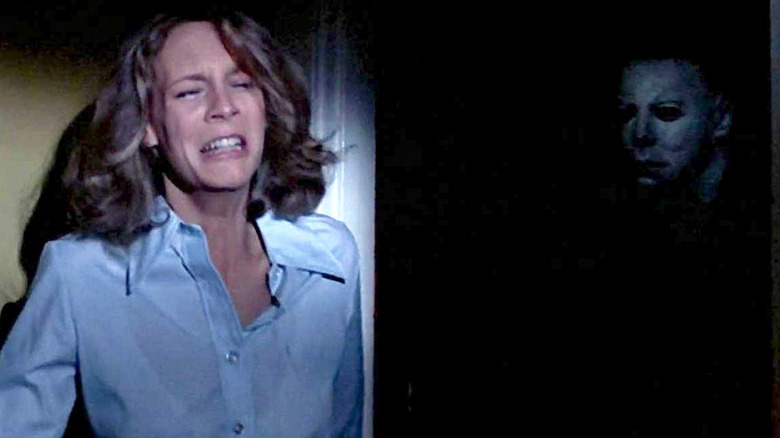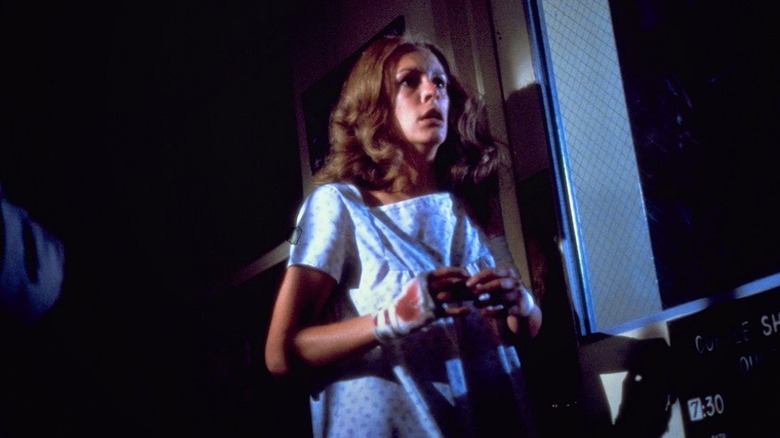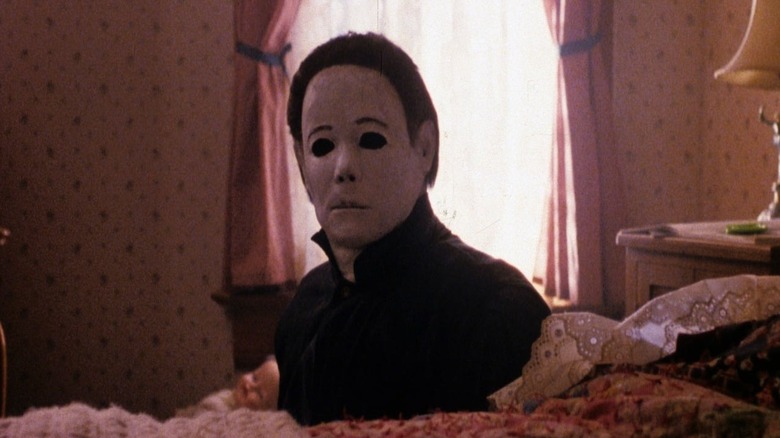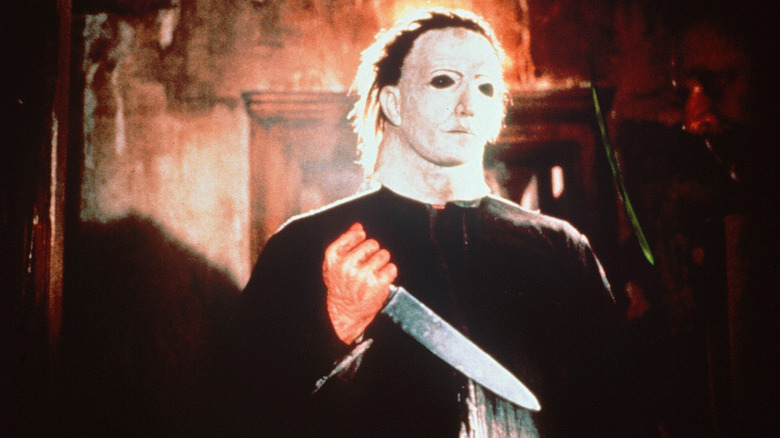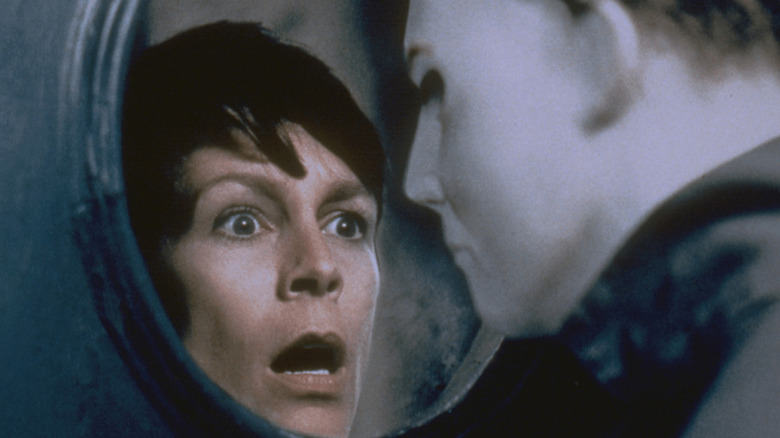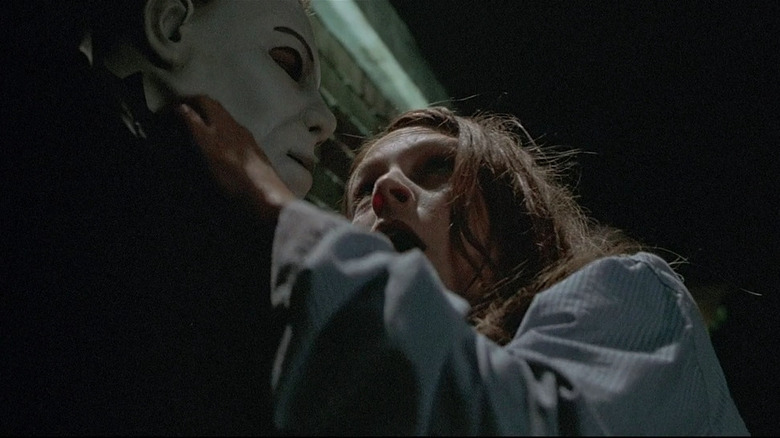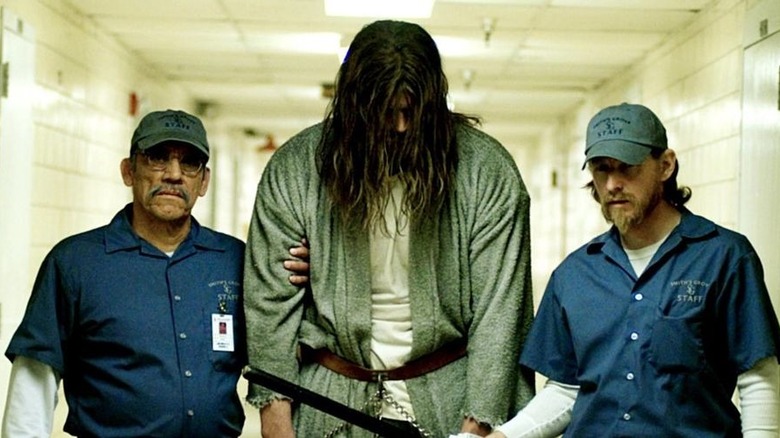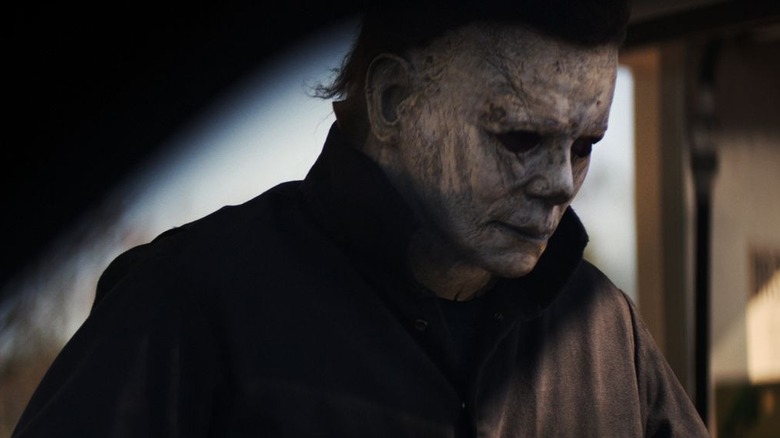Michael Myers' Backstory Explained
Freddy Krueger. Jason Voorhees. Michael Myers. These are arguably the most iconic horror movie villains of all time — and while Freddy and Jason have dominated the box office, the "Halloween" franchise is still slashing, just like its unstoppable antagonist. The series has seen multiple sequels, resets, and reboots, and none of it would have happened without Michael.
Michael Myers is the lifeblood of the "Halloween" franchise. A horror movie legend, he's so frightening because he can't be taken down and — in his purest, most evil depiction — has no discernible motive for his heinous acts. But even evil incarnate has an origin story.
That story has gotten pretty convoluted over the years. Throughout the franchise the timeline diverges multiple times, and the main series even features one entry without Myers. But we're here to help sort through it all, so grab your favorite carving knife and let's dig in. This is Michael Myers' backstory explained.
The origin of Michael Myers
The story of Michael Myers begins on Halloween night in 1963 in the suburban town of Haddonfield, Illinois, as six-year-old Michael gets up, walks into his sister's room, and stabs her to death. He's sent to Smith's Grove Sanitarium, where he spends the rest of his childhood and adolescence being observed and studied by Dr. Sam Loomis, who winds up becoming an expert on the man, the myth, the legend that is Michael. Loomis, played by Donald Pleasance, will turn out to be a major character in the franchise.
During his time with Michael, Loomis came to fear him, and even view him as something other than human. "I met this ... six-year-old child with this blank, pale, emotionless face, and ... the blackest eyes — the devil's eyes," said Loomis. "I spent eight years trying to reach him, and then another seven trying to keep him locked up, because I realized that what was living behind that boy's eyes was purely and simply ... evil."
This description of Michael would go on to define the character.
Michael Myers on Halloween 1978
On October 30, 1978, the story of Michael Myers begins in earnest. He escapes from Smith's Grove the night before Halloween and descends upon Haddonfield, but not before a stop at a hardware store where he picks up his trademark mask. This first movie establishes the rule that in the "Halloween" series, we never see Michael's face. Once he puts the mask on, the transformation from the boy Loomis once met to the serial killer we all know and fear is complete.
Meanwhile, high schooler Laurie Strode (Jamie Lee Curtis in her first film role) is preparing for a boring Halloween night babysitting young Tommy Doyle near the Myers home, now abandoned. Of course, we all know a quiet night at home is not quite how it ends up going for poor Laurie. She ends up at the tail end of Michael's killing spree, outwitting him and stopping him several times, but not enough to stop his pursuit. After a night of tracking Michael, Loomis comes to the house where Laurie is fighting him off and manages to put six bullets in him. That's enough ... for now.
The big reveal of Halloween II
Later that night, Laurie is brought to the Haddonfield Memorial Hospital for the injuries she sustained during the events of the first movie. In the events of "Halloween II," the Rick Rosenthal-directed sequel to John Carpenter's classic, Michael returns and comes after Laurie at the hospital. The sequel begins what would become a major expansion of the "Halloween" lore, as it were, making a connection between Michael and Laurie and giving him a more direct motivation.
During a scene that happens late in the movie, it's revealed that Laurie is Michael's sister. She was extremely young when he was locked away and doesn't remember her birth family — taken in by the Strodes and raised as one of their own, she's been shielded from the truth. This explains why Michael is so dead set on killing Laurie — he wants to finish what he started. This explanation arguably makes Michael a less compelling villain, but it does set the stage for the next three films in the Myers saga. In the meantime, "Halloween II" ends with Michael being (presumably) killed in a fire at the hospital.
Halloween 4 brings Michael back to the franchise
The third "Halloween" movie was an experiment that tried to take the franchise in an anthology direction — and away from Michael Myers. After "Halloween III: Season of the Witch" earned lukewarm reviews and disappointed at the box office, the "Halloween" series fell into limbo for years — and after it returned with 1988's fittingly titled "Halloween 4: The Return of Michael Myers," it never again strayed from the unfeeling killer at its core.
The "Thorn trilogy" — as it was later referred to — begins "Halloween 4," starring Danielle Harris as Jamie Lloyd, Laurie Strode's daughter. Jamie is living with a foster family and has recurring dreams of Michael coming to get her. Those dreams turn out to be warnings when Michael wakes up from a 10-year coma and goes after his closest living relative (as by now it's been established that's what Michael's motivations are). The movie ends in a standoff near an abandoned mine, but only after depicting a moment of psychic connection initially established via physical contact with Jamie.
In the final moments of "Halloween 4," the Lloyd family returns home to find a horrifying sight: Jamie, dressed in the costume Michael wore that night in 1963, holding a bloody pair of scissors. Dr. Loomis tries to shoot her, but is thwarted.
Halloween 5 and 6 expand the Myers lore
As "Halloween 5: The Revenge of Michael Myers" begins, Jamie is mute and in a psychiatric hospital after attempting to kill her foster mother at the end of the previous film. This is implied to be the result of a moment she shared with Michael in the last movie, sparking a connection that leaves Jamie suffering hallucinations that keep her bond with Michael shrouded in mystery. This isn't fully explored and explained until the sixth "Halloween" movie, "The Curse of Michael Myers," which goes full on "ancient mystic cult" in its attempt to explain the title character's story.
In "The Curse of Michael Myers," Michael returns to his childhood home to kill — guess who? — the Strode family that now lives there. Tommy Doyle, now an adult, still lives across the street. Doyle has been studying Michael and has discovered the root of his evil: An ancient Druid curse known as "Thorn." This brings the family connection full circle, as the conditions of the curse say the inflicted must kill their next of kin on Halloween night. It's been widely derided among the fanbase, but for better or worse, "The Curse of Michael Myers" is a thorough explanation of the killer's backstory, and it left the franchise out of narrative runway to keep expanding for several years.
H20 reset the timeline for the first time
For the first time (yet far from the last) in the "Halloween" franchise, the timeline was reset in 1998, when the producers behind the series decided to completely jettison the convoluted curse story told during the last three movies. Made 20 years after the original, the (again) fittingly titled "Halloween H20: 20 Years Later" brought Jamie Lee Curtis back for a story pitched as a direct sequel to "Halloween II." This movie returns Michael's motivations to their roots — specifically, finding and killing Laurie Strode.
"H20" brings Michael from Haddonfield to California, where Laurie has built a new identity and life for herself as a schoolteacher. He's determined to ruin that for her, of course — and of course, he's foiled again with what looks like the most definitive Michael kill yet: Laurie chops his head off with a fire axe. Any viewers who were actually convinced this was finally the end of the un-killable killer would only need to wait four years to find out what really happened that fateful night ... and why it would nearly spell the end of "Halloween."
Halloween Resurrection kills off a major character
To put it simply, "Halloween: Resurrection" reveals that the ending of "H20" was an illusion for the viewer as well as Laurie. Of course the decapitated man wasn't Michael — Laurie actually murdered an innocent man, and has now been institutionalized. "Resurrection" begins by showing this in a flashback and establishing Laurie as a paranoid patient, waiting for Michael's arrival the following Halloween night.
Despite Laurie's best-laid traps, Michael breaks into the sanitarium where she's being held and chases her to the roof. She's about to kill him, but her last encounter gives her doubt and she begins to grapple with his mask to make sure it's the real Michael. That doubt gives Michael enough time to stab and finally kill Laurie, tossing her off the roof.
Beyond these bonkers opening minutes, not a whole lot else of note happens in "Resurrection," which ends up putting an early aughts reality TV spin on the series. This opening feels more like a coda to "H20" than an opening to "Resurrection," and frankly doesn't have to much to do with the main story of the 2002 movie at all. Laurie's death could have been a huge moment in the "Halloween" canon, but it finally left the franchise nowhere to go but back to the beginning.
Halloween Zombified
In 2007, the franchise returned thanks to Rob Zombie, who directed a remake of the original 1978 Carpenter classic. This poorly received installment more or less retold the story of the first movie — and many felt it didn't hold a candle to the original, making this one of the worst movies in the "Halloween" series.
Zombie followed it up with "H2," which focuses on the relationship between Michael and Laurie. Two years after the events in Haddonfield, Laurie begins having hallucinations like the ones Jamie experiences in "Revenge of Michael Myers," in which she sees herself acting out Michael's past murders. Following tradition, the movie also reveals Laurie to be Michael's sister, Angel Myers — only at the end of this film, Laurie manages to actually kill Michael. After stabbing him with his own knife, Laurie puts on his mask and walks out as the new "Michael Myers."
The movie is bookended with scenes of family matriarch Deborah Myers giving first Michael — and later Laurie — a white horse figurine, implying that somehow this evil is hereditary and passed on from their mother. It's a unique twist on the Michael Myers origin story that can only be found in Rob Zombie's take on the character.
Halloween goes back to basics
With the 2018 reboot/reimagining "Halloween," the series went back to basics, giving viewers a direct sequel to 1978's "Halloween" and disregarding the big twist connecting Laurie and Michael in "Halloween II."
In this timeline, Michael has been incarcerated for the past 40 years for the murders he committed in the first movie. During the events of the 2018 "Halloween," he breaks out to track down and kill Laurie, who is definitely not his sister. Over the years, Laurie has become a reclusive alcoholic who's very good at setting traps for Michael — you could say it's become her life's work. It pays off, because a trap she lays for him sets her house ablaze, with Michael presumably dead inside.
With "Halloween Kills" on the horizon, it's clear Michael also survived that fire — and it looks like this time, Laurie gets her chance to hunt him down instead of the other way around.
